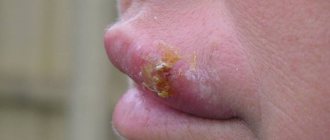Every child at an early age comes into contact with viruses and bacteria every day. Children's immunity is not yet strong enough to cope with infection. This makes the baby’s body vulnerable to various kinds of ENT diseases. Runny nose, cough, high temperature, sore throat - these symptoms are familiar to every parent firsthand. Medical statistics provide the following figures: a preschool child gets a cold up to eight to nine times a year!
Sometimes the above symptoms are accompanied by one more: the child is hoarse or hoarse. The problem of a baby’s hoarse voice is not perceived by parents as something out of the ordinary and is considered within the framework of a cold. Meanwhile, a condition when a child’s throat becomes hoarse and hoarse, when the voice deepens, can speak not only of a cold, but of serious disorders in the child’s body.
What to do if a child’s voice is hoarse? Should I treat it myself or sound the alarm and call a doctor? What can cause a baby’s throat to become hoarse and hoarse? How to treat a hoarse throat safely and effectively, and what is absolutely not recommended to do? “A child’s hoarse voice” is the topic of a new article.
The child’s voice deepens: physiology.
The human larynx plays a leading role in the process of voice formation. It contains vocal cords - clusters of muscles that, when in contact with a stream of air leaving the lungs, close together and begin to move (oscillate and vibrate). As a result of these vibrations, sound is generated. If the ligaments do not close tightly and lose their mobility, the voice sounds distorted: we say that it is sitting down, or that our throat is hoarse or hoarse. A condition in which the vocal cords become hoarse is most often associated with their swelling.
ENT diseases in infants and preschoolers are a very common occurrence. This is due to the anatomical features of the larynx in childhood. The larynx in babies is smaller than in adults. The same can be said about the vocal cords: the cords in infants are very small (no more than eight millimeters), in school-age children - about twenty millimeters. These structural features of the vocal apparatus lead to the fact that the child’s ligaments shrink quite often.
Many parents associate only a cold with hoarse vocal cords. But in reality, there are many more reasons why your throat may become hoarse and hoarse. And before you understand what to do next, and how to treat hoarse ligaments, you need to find out why the baby’s voice has become weak.
What is the danger of a hoarse voice?
Despite the apparent insignificance of the symptom, hoarseness, regardless of what causes it, is dangerous. There are several reasons for this. Firstly, this sign in most cases indicates the presence of inflammation in the larynx. In an advanced form in a child, this process can lead to problems with the patency of the respiratory tract and the ventilation capacity of the lungs. The second reason is the anatomy of the child’s throat, which has its own characteristics. A child's throat is much narrower in diameter compared to an adult's throat, which means swelling in it can occur much faster and progress more actively.
An additional risk lies in the fact that a hoarse voice can be an indirect symptom of a very dangerous disease - diphtheria croup. In this case, a consultation with an ENT specialist should be accompanied by an examination by a pediatrician. Currently, vaccination against diphtheria is mandatory in Russia, so such cases are recorded extremely rarely. But even vaccination cannot guarantee one hundred percent protection, and the disease can manifest itself even in a vaccinated child.
That is why a hoarse voice should be a reason to show the child to the doctor. A pediatric otolaryngologist will determine whether the baby has diphtheria and identify the cause and focus of the inflammatory process. The sooner the consultation with an ENT specialist takes place, the better, since with this symptom the child may have an attack of suffocation at any time.
If a symptom suddenly appears, especially in combination with difficulty breathing, you should call a doctor at home or an ambulance. Before the doctors arrive, you need to provide the child with complete rest and give as much fluid as possible.
A child's throat is hoarse and hoarse: reasons.
Hoarseness (a condition where the voice becomes shallow) is medically called dysphonia. It can appear in parallel with other symptoms (cough, runny nose, high fever), or it can occur independently when there is no fever or other symptoms of inflammation. The last option requires the most attention, since a hoarse voice without fever can indicate dangerous diseases.
The following reasons lead to a condition where a child’s throat may become hoarse and hoarse and his voice may become dry.
Make an appointment right now!
Call us by phone or use the feedback form
Sign up
- Viruses. Pathogenic microorganisms enter the baby’s body through the nasal cavity, and if nothing is done or treated at an early stage, the viruses penetrate lower into the pharynx and larynx, where they trigger the inflammatory process. Inflammation leads to swelling of the vocal cords, as a result of which the child’s throat may become hoarse and hoarse, and the voice may become dull. The disease occurs with a cough, runny nose, and fever. Such diseases include colds, flu, various forms of ARVI, etc.
- Infectious diseases such as laryngitis, tracheitis, pharyngitis, tonsillitis, diphtheria. With these diseases, not only can the throat become hoarse or hoarse, but the temperature can also rise to high levels. Most often, this inflammatory process, in which the voice deepens and the body temperature rises, is caused by a bacterial infection. These conditions must be treated under the supervision of an ENT doctor. If you do nothing and let the disease take its course, serious complications may arise.
For example, if a sore throat is not treated and procedures are not performed in an ENT clinic, problems with the heart, kidneys and joints may appear. The condition “diphtheria croup” is especially dangerous, in which hoarseness is one of the main symptoms. It can lead to death from suffocation.
- Allergy. An allergic reaction in a child, in which the voice deepens and the throat hoarses, is a very dangerous phenomenon. If your baby suddenly develops a hoarse or hoarse throat and has difficulty breathing, you should immediately call an ambulance, as suffocation may occur. What you can't do in this situation is panic. You need to calm the crying baby, because crying only aggravates the situation, give an antihistamine and wait for the doctors to arrive. In case of an allergic reaction, the following symptoms are also possible: runny nose, lacrimation, cough, fever.
- A foreign object in the child's larynx. Children are distinguished by their rare curiosity and during play can easily put small toys or their parts into their mouths and inadvertently swallow them. The smallest children cannot explain what happened. Therefore, if the baby is hoarse or hoarse, and his voice becomes dry without fever or other signs of inflammation, you need to be wary. What to do? First of all, show the child to an ENT doctor. Examination will reveal the presence of a foreign object in the larynx.
- Overstrain of the vocal cords. During the period of growing up, the child’s vocal cords are just developing, so due to prolonged crying or loud screaming, the baby can easily become hoarse or hoarse. In this case, signs of inflammation such as fever and runny nose will be absent.
- Burns of the larynx. It is not only hot food or liquid that gets into the larynx during a meal that makes the voice hoarse, but also steam inhalations, which some parents like to use to treat their children when the first signs of a cold appear (when the throat hurts, the voice deepens, the temperature rises).
- Neoplasms of the larynx. Hoarse ligaments without fever and other signs of infectious diseases can signal the presence of neoplasms in the larynx (papillomas, tumors, etc.)
- Voice goes down after sleep. It happens that the baby wakes up hoarse without fever or sore throat, but as soon as he clears his throat, everything goes away. In this case, the ligaments shrink due to too dry air in the apartment. What to do about it? There is no need to treat hoarseness. Buying an air humidifier solves the problem of hoarse ligaments in the morning.
- “Breaking” of a teenager’s voice. In boys, during the period of hormonal changes in the body, the ligaments may also shrink, and the throat may become hoarse without fever. You don't need to do anything about it. The hoarse ligaments will recover on their own - this is a variant of the norm.
A hoarse throat with or without fever is not as simple a symptom as it might seem at first glance. It can be a consequence of a common cold, or it can signal dangerous diseases. Therefore, when hoarseness appears, the first thing to do is to show the child to an ENT doctor.
Hoarse throat: diagnosis and how to treat?
In order to correctly diagnose and determine the cause of hoarseness, the ENT doctor conducts a thorough diagnosis of the little patient. First, the doctor interviews parents about complaints and symptoms. Then he examines the nasopharynx using endoscopy, palpates the lymph nodes, and, if necessary, performs laryngoscopy (examination of the larynx). If the problem does not lie in the ENT organs, you will need to consult doctors of related specialties: an allergist, oncologist, etc. If the cause of hoarseness is infectious, you will need to undergo a series of laboratory tests.
Friends! Timely and correct treatment will ensure you a speedy recovery!
How to treat hoarseness? Depending on the reason that caused it. Therapy may include:
- antibacterial or antiviral drugs (depending on the causative agent of inflammation);
- antihistamines that relieve swelling;
- antipyretics for fever;
- antiseptic sprays;
- lozenges;
- rinsing solutions;
- cough suppressants;
- physiotherapeutic procedures.
Among tablets for voice restoration, pay attention to Homeovox. Regular tablets and lozenges help with sore throat. But if your voice is dry or hoarse, then you need Homeovox. This is the only drug for treating voice in all types of laryngitis, including overstrain of the vocal cords. The components of the medicine are selected in such a way that they have a complex effect. It is usually prescribed to children over 6 years of age, since they can already dissolve tablets and will not swallow them. It is recommended to start taking Homeovox from the very beginning of hoarseness or hoarseness in children. In the first days, the tablets need to be dissolved quite often, 2 tablets every hour (but no more than 24 tablets per day), between meals. This is good, since the medicine also helps relieve discomfort in the child’s throat, such as dryness and tickling. Then, as the voice returns, they switch to taking 2 tablets five times. Homeovox combines well with other drugs, so you don’t have to be afraid to combine it with other treatment regimens.
If hoarseness is caused by overstrain of the ligaments, vocal rest, plenty of warm drinks and maintaining the proper level of humidity in the apartment are necessary.
Why is it necessary to treat chronic laryngitis in a child?
Treatment of chronic laryngitis in children should begin immediately after identification, since the problem can lead to a number of adverse consequences:
- persistent hoarseness of the voice or its disappearance;
- spread of infection to nearby organs;
- malignant degeneration of overgrown epithelial tissues;
- persistent narrowing of the lumen of the larynx with difficulty breathing and chronic lack of oxygen in the body.
Therapy for chronic laryngitis is difficult and lengthy, requiring an integrated approach. In some cases, with the development of irreversible changes in the structure of the laryngeal mucosa, surgical intervention is required2. To avoid unnecessary trauma to the child, it is recommended to begin treatment immediately after identifying the problem.
Prevention.
To avoid dangerous consequences for children's health, do not forget to vaccinate your baby according to the vaccination calendar, in particular, vaccinate against diphtheria.
Treat respiratory diseases promptly. Contact your doctor at an early stage, when the disease can be treated quickly and without complications.
Temper your child, including using local hardening of the throat: even ice cream eaten in small portions will benefit local immunity. Walk in the fresh air more often, teach your baby to sports and physical activity.
Maintain optimal levels of humidity and temperature in the room.
Avoid crowded places during epidemics. If this cannot be avoided, thoroughly wash your baby’s hands and rinse his nasal passages with saline solutions.
It seems like simple rules, but if you follow them, you won’t have to treat serious illnesses.
If you or your family members do get sick, do not self-medicate, but rather come to our ENT clinic. We treat adults and small patients from three years of age.
To make an appointment, please call: +7 (495) 642-45-25;.
We will definitely help you!











